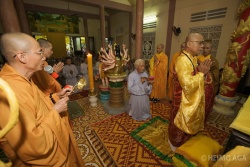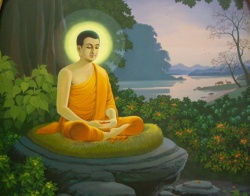Perennial wiews on Education and Buddhism
PERENNIAL EDUCATION IS BASED ON THE THEORY OF PRIMORDIAL concepts. Perennialists concern about traditional knowledge, which they believe, should be handed down without change. According to this view, traditional knowledge is eternal and unchanging. Explaining the view of “Perennialism and Education” Gutek points out that “The term perennialism comes from the assertion that the important principles of education are changeless and recurrent.” The perennial ontological idea is that the truth of the universe is perfect and everlasting and permanent fact that never changes. The “unchanging” concept of perennialism is based on the notion of theological philosophy. This belief in permanence contradicts the Buddha’s philosophy of impermanence (Anicca in Pali, and Anitya in Sanskrit). As the Buddha pointed out, “all component things are impermanent (Sabbe samkhara aniccati).”
According to the philosophy of the Buddha, in order to achieve highest knowledge and wisdom, one should realize the universal reality of impermanence that everything is constantly changing. This “Changing” reality of the world, the “suffering” of all beings due to ignorance, and the “non-self” of mind and mentality can be realized through the practice of morality, self-awareness, and wisdom (sila, samadhi and panna). In Buddhism, the nature of these truths is expressed in six qualities: 1) Truth is well-expounded by the Blessed-One; 2) Truth can be realized (here and now); 3) Truth is immediately effective or truth is timeless; 4) Truth calls one to come and see (not through blind belief); 5) Truth is leading onwards; and 6) Truth is to be personally realized by the wise. Anybody can see the reality of truth, which exists within universal nature. This expression of understanding the truth and reality of the world is very different from the primordial wisdom of perennialism. But we should keep in mind that the Buddha’s discovery of the Four Noble Truths, Noble Eight-Fold Path, the Three nature (ti-lakkhana in Pali tri-laksana in Sanskrit), the Thirty-seven Factors of Enlightenment, are the reality of the world which exists forever with change. According to the “Abhidhamma teaching, these truths can be categorized as ‘Absolute Truth’” (paramattha sacca in Pali and paramartha satya in Sanskrit). But “Conventional truth” (Sammutisacca) is always subject to change. Therefore, perennialist views on worldly education can be categorized as “Conventional Truth” which can changed at any time. It is good to notice that perennialists urge all students to develop first their intellectual knowledge, and, secondly, to practice morality.
The Buddha emphasized that knowledge must be endowed with moral conduct. Without morality, the mere acquisition of knowledge is groundless. Similarly, perennialists are also deeply concerned about the cultivation of ethical principles and encourages moral, aesthetic, and religious criticism and appreciation. Concerning the subject matter of pereninialist education, Gutek points out that “The perennialist educational theory seeks to develop the intellectual and spiritual potentialities of the child to their fullest extent through a subject-mattercurriculum based on such disciplines as history, language, mathematics, logic, literature, the humanities, and Science.
These subjects, regarded as bearing the knowledge of the human race, are the tools of civilized people and have a disciplinary effect on the human mind”. Gutek further points out that humankind has captured a glimpse of eternal truths and values which are found in science, philosophy, literature, history, and art, and which have persisted as they are transmitted from generation to generation, for example, from Plato and Artistotle, to John Stuart Mill.” Larry Ja. Shaw points out that perennialists recommend that students learn directly from reading and analyzing the Great Books. These books are creative works by history’s finest thinkers and writers that are as profound, beautiful, and meaningful today as they were when they were written. This view is found in the traditional orthodox Theravada school of Buddhism, in which all students are urged to learn the collection of the three canonical teachings (Tipitaka-Dhamma) as the most authentic wisdom of the Buddha. The orthodoxy of Theravada Buddhism is quite similar to the perennialist concept of adhering to ancient wisdom without change. Therefore, Theravada Buddhist concept of adhering to ancient wisdom without change. Therefore, Theravada Buddhists do not accept the teachings of any other sect of Buddhism that developed in later periods. The orthodoxy of monks towards the teachings (Dhamma) recalls perennialism, although the Buddha himself was quite progressive, in the sense that he encouraged freedom of teachings, thinking, and putting into practice without grasping at tradition. The Buddha advised monks to change the minor discipline, if the Sangha wished to do so but, ironically, orthodox senior monks never want to make changes, claiming to have preserved the Buddha’s dispensation (Buddha-sasana) in pristine purity as it was expounded 2600 years ago.

